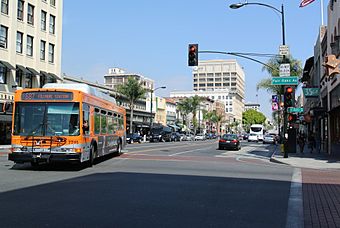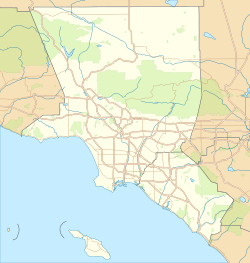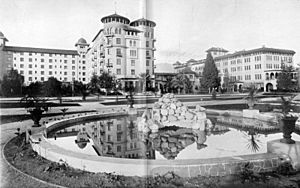Old Pasadena facts for kids
Old Pasadena, also known as Old Town Pasadena, is the historic downtown area of Pasadena. It was once the main shopping and business center for the city. After a time when it wasn't doing so well, Old Pasadena has been brought back to life and is now a popular spot.
This area was a hub for science and research. Important places like Caltech and the Jet Propulsion Laboratory started here. Companies like Beckman Instruments and Aerojet also began in Pasadena. Because of all this innovation, the area was nicknamed "Athens of the West."
Old Pasadena was also a place for art and new ideas. Famous artists like Andy Warhol and Marcel Duchamp had their first big shows here. The Pasadena Art Museum, now the Norton Simon Museum, was one of the first modern art museums in the country. In the past, Pasadena was also known for movements like women's voting rights and peace efforts. By the 1940s, the downtown area faced some challenges. But by the late 1980s, Old Pasadena began a big comeback, becoming the lively place it is today.
Contents
Exploring Old Pasadena's Past
The Heart of Old Pasadena: Fair Oaks and Colorado
The very center of Old Pasadena is where Fair Oaks Avenue (running north-south) and Colorado Boulevard (running east-west) meet. This intersection was important from the start. The first businesses of the original Indiana Colony were set up here. J. D. Hollingsworth's general store was the main place for supplies. It even served as the post office when mail arrived from Los Angeles.
On the northwest corner, you would have found the Grand Hotel. On the southwest corner, the Williams family owned Williams Hall. This building was later updated and became the Dodsworth Building. Today, it houses the Dodsworth Hotel.
The Story of Castle Green
As Pasadena grew, grand hotels were built to attract wealthy visitors in winter. In 1887, Edward C. Webster started building a hotel. When he couldn't finish it, Colonel George Gill Green took over. The Green Hotel opened in 1888.
Colonel Green was friends with Andrew McNally, a famous printer from Chicago. McNally had invited Green to live in this new community. Green and McNally invested in the Altadena Railroad. This train line even had private stops at their homes.
The first Green Hotel was a large, six-story building. It faced Central Park and was near the old Pasadena Train Station. In 1898, Green built an even grander hotel across Raymond Avenue. This new building was in the Mediterranean style. The first hotel became known as the "annex." The new, grander building became a winter home for important business leaders.
The two buildings were connected by a bridge over Raymond Avenue and a tunnel underneath. Guests arriving by train would go through the annex and then across the bridge to the main hotel. In 1924, the hotel was turned into apartments. The original annex building was mostly taken down. Today, only a small part of that first hotel remains. The main building from 1898 is now called the Castle Green. It's a beautiful historic landmark.
Other Important Buildings and Changes
Many other buildings were constructed in Old Pasadena over the years. In 1887, a three-story brick building called the "Doty Block" was built. It once showed off stagecoaches. Later, it became The Mikado Hotel, serving the Japanese-American community. It also served as a freight depot for a local railroad.
From the 1900s to the 1940s, Downtown Pasadena changed quickly. The city's population kept growing. Even during the Great Depression in the 1930s, the area kept developing. Hotels were turned into offices for industries and research. This shift helped Old Pasadena continue to grow.
In the 1940s, the Doty Block became Pasadena's first Black-owned hotel, the Hotel Carver. It was bought by Percy Clark and his sons. In the basement, there was a famous jazz club called the Onyx Club, later the Cobra Club. In 1970, the hotel was sold and became studios for artists. Many artists, musicians, and writers used the space. The building was also known for the John Bull English Pub. In 1985, the artists moved out and the building closed. After an earthquake in 1987, the building was repaired and updated.
In 1929, Colorado Boulevard was made wider on the north side. Many fancy Victorian building fronts were removed and replaced with newer, simpler ones. Kansas Street was also widened and renamed Green Street.
Old Pasadena's Historic District
Saving History: The Historic District
In the 1970s, Downtown Pasadena was facing tough times. The city had a plan to improve the area. This plan included tearing down old buildings to make way for new ones. However, a group called Pasadena Heritage stepped in. They were founded in 1977 to save historic buildings. They fought to protect and restore the existing structures.
Because of these efforts, the Historic Old Pasadena District was officially recognized in 1980. It was defined by specific boundaries. This was done to help bring new life to the oldest part of Pasadena. The area had become run-down and businesses were struggling.
With this new status, a controlled plan for redevelopment was put in place. There were special tax benefits for investors who helped. Under strict rules, old paint was removed from buildings, showing off the original brickwork. All renovations were carefully watched by a city group. They approved the materials, colors, and styles. Most of the changes were meant to look like the period from 1925 to 1940.
The Old Pasadena Historic District was officially listed on the National Register of Historic Places in 1983. This is a list of places important to American history.
Old Pasadena Today
After businesses started leaving Downtown Pasadena in the 1950s, the area declined. It was even called "Skid Row" because many buildings were empty. But since then, Pasadena's downtown has been completely revived. It is now known as "Old Pasadena." It's one of Southern California's most popular places for shopping and entertainment.
The downtown area's redevelopment involved a lot of money, over $400 million from public and private sources. This money helped build new parking garages and a shopping center. But it also helped fix up existing buildings. The goal was to bring back the look and feel of old Downtown Pasadena. As these plans finished, Old Pasadena continued to grow. It became a great example of "smart growth" for California. This means it has a mix of housing, shops, and offices, which helps the area grow in many ways.
Today, Old Pasadena is mainly a business district. It has a shopping mall, fancy restaurants, a movie theater, and many shops. You can also find outdoor cafés, pubs, and comedy clubs. It's a lively place, especially at night. Many buildings also have offices and apartments on their upper floors. The Pasadena Playhouse is also located in Old Pasadena.
Old Pasadena is easy to reach by public transport. The Metro A Line light rail connects it to Downtown Los Angeles. The Del Mar station is just two blocks south of Colorado Boulevard. The Memorial Park station is also nearby. The Norton Simon Museum is located at Orange Grove Boulevard and Colorado Boulevard.
Every New Year's Day, the famous Tournament of Roses Parade travels through Old Pasadena on Colorado Boulevard. This amazing event draws about 1.5 million people each year. Thousands of them even camp out overnight to get the best view of the parade.
Old Pasadena also hosts ArtPerformance, an annual outdoor music event. It features free concerts on different stages. This happens during PasadenART Weekend, a three-day citywide art event.
Some street crossings in Old Pasadena use a special system called a pedestrian scramble. This means all traffic stops, and people can walk across the intersection in any direction, even diagonally. This system is also used in places like Tokyo and Las Vegas Strip.
 |
La Cañada Flintridge & JPL & Rose Bowl Stadium | I-210 & Altadena | Altadena |  |
| Glendale & CA 134 | East Pasadena | |||
| Eagle Rock, Los Angeles | South Pasadena & CA 110 | San Marino & Caltech & Huntington Library |
Getting Around Old Pasadena
Public Transportation
The Metro A Line light rail has two stations in Downtown Pasadena: Memorial Park and Del Mar. Many bus lines also serve the area. These include Metro Rapid lines 762 and 780, and Metro Local lines. Pasadena ARTS and Foothill Transit also have routes that stop here.
Main Streets in Old Pasadena
- Arroyo Parkway
- Colorado Boulevard
- Fair Oaks Avenue
- Holly Street
- Orange Grove Boulevard
- Pasadena Avenue
Nearby Highways
- U.S. Highway 66
- Interstate 210
- California State Route 110
- California State Route 134
- California State Route 710
Famous People Connected to Old Pasadena
Some notable people have lived or spent time in Old Pasadena. These include General George Patton, artist Alexander Calder, writer Upton Sinclair, and chess champion Bobby Fischer.








